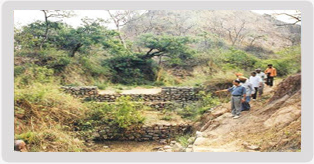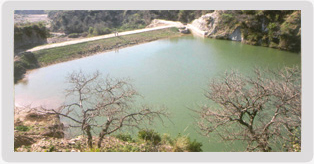The survival of an agrarian society depends on the agricultural productivity which is directly related to the top soil of earth and moisture regime. The top soil and moisture availability are adversely affected by deforestation. Sparse or little vegetation leads to soil erosion, high run-off, siltation and flash floods. The Shiwalik hills in northern Haryana constitute a major watershed for a large portion of the state. These hills are highly degraded with very little forest cover. As a result, heavy soil erosion takes place during monsoons. Various vegetative, mechanical, soil and water conservation measures are being taken to conserve the top soil, to reduce the fury of the floods and to improve ground water regime.
Soil and Water Conservation Structures
 The Catchment area treatment is done by structural interventions coupled with biological remedial measures and social fencing to reduce soil erosion, break length and degree of slope and prevent scouring and undercutting of hill surfaces, channel banks and stabilized channel bed slopes.
The Catchment area treatment is done by structural interventions coupled with biological remedial measures and social fencing to reduce soil erosion, break length and degree of slope and prevent scouring and undercutting of hill surfaces, channel banks and stabilized channel bed slopes.
The structural measures include staggered contour trenches, peripheral trenches, gully plugs, spurs, studs, check dams, silt retention dams, relevant crate wire structures, and drop structures.
The bio-remedial measures include vegetative/brushwood check dams across channels, vegetative spurs in single or double lines, vegetative filters and grass barriers, vegetative gully plugs, and stabilization of pondage area by planting trees and mulching with locally available biomass.
In addition to structural and bio-remedial measures, the effective closure to animal grazing and illicit felling of vegetation with peoples active participation can be most effective social fencing measure in rehabilitation of degraded catchments. Awareness and motivation are needed both among the local people, NGOs and public functionaries.
Water Harvesting Structures
 The term water harvesting in its original application is perhaps defined as the collection and storage of any farm water, either runoff or creek flow for irrigation use. Later in the process of modification, the scope of the definition has been broadened to mean the process of collecting natural precipitation in a storage structure from a treated watershed catchment. Water harvesting is a dominant source of irrigation in the Shivalik foothill region, where there is no possibility of developing other sources of irrigation.
The term water harvesting in its original application is perhaps defined as the collection and storage of any farm water, either runoff or creek flow for irrigation use. Later in the process of modification, the scope of the definition has been broadened to mean the process of collecting natural precipitation in a storage structure from a treated watershed catchment. Water harvesting is a dominant source of irrigation in the Shivalik foothill region, where there is no possibility of developing other sources of irrigation.
It has been realized that water is the most important and unspoilt forest produce. Harvesting a greater amount of this resource for increasing agricultural production is the most important initiative. This activity was started about 25 years ago and more than 200 Rain Water Harvesting Structures have been constructed in Shivaliks & Aravallis. To conserve water in Aravalli and Shivalik Hills, Integrated Watershed and Afforestation Projects are being formulated in the state. The implementation of these projects will improve the productivity of agricultural crops and the yield of milch animals. The novel idea of rehabilitation of ‘Village Ponds’ has been initiated by the Forest Department. The village johads, which in earlier times served the purpose of storing rainwater to be used for various water requirements in the village had slowly degenerated owing to disuse. Many of these village ponds have been rehabilitated in past under JICA Project and under state schemes.
From material and design consideration, Water Harvesting Structures include small earth-fill dams, stone masonry dams, water percolation dams, and sub-surface dams. The sub-surface dam is a later innovation to tap sub-surface channel water for irrigation and water supply.

